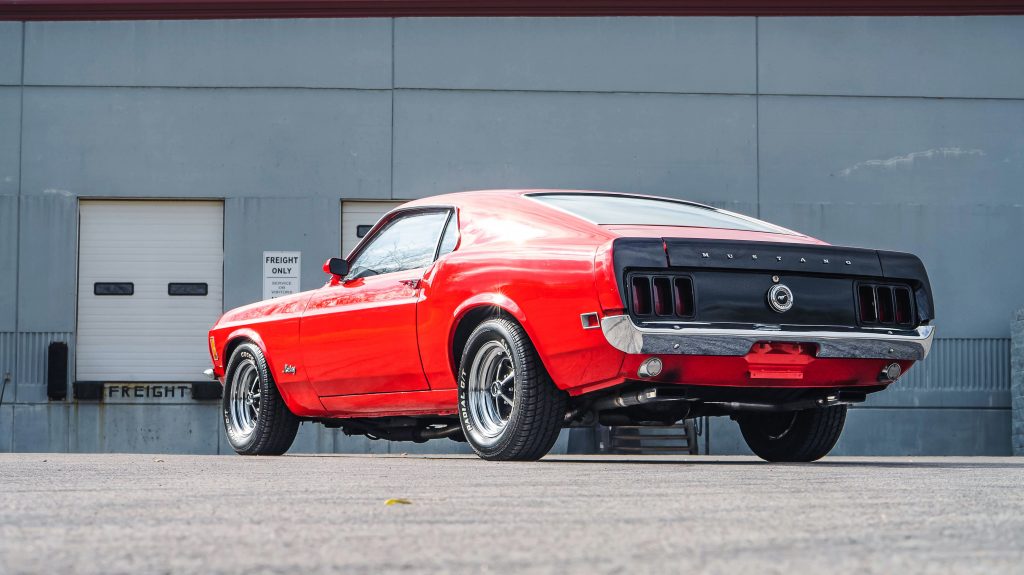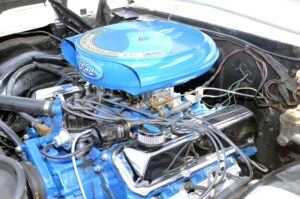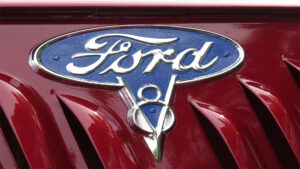1969 Vs. 1970 Mustang: Pick Your Pony

The year was 1969, and quite a bit happened in the automotive world, which was deemed by many as one of the most exciting times for muscle cars to date.
From its debut in 1964, the Mustang went relatively unchanged until 1968 due to a lack of competition and dominated a market they had all to themselves. It wasn’t until 1967 when Dodge and Chevrolet realized what Ford had with the Mustang, leading them to debut muscle cars of their own and kick off a battle that still exists today. Ford had to respond – they were forced to make some significant updates and evolve on a dime due to the new additions from Dodge and Chevrolet.
Once the competition started, Ford endured a year-to-year loss of 5.5 percent between 1968 and 1969. It wasn’t their market any more. Since the blue oval had sunk a lot of cash into development, it warranted concern. There was a lot of money, time, and effort spent overhauling the 1969 Mustang, which is obvious by the seemingly endless amount of trims available. There was a sense of reluctance to go crazy with the 1970 model, meaning the upgrades don’t appear to be much.
Despite the minimal upgrades, the Mustang started making a name for itself again in 1970 when the popular Parnelli Jones helped Ford reclaim the Trans-Am manufacturer’s trophy. Although this was great news and launched them into the limelight, they were still sagging in the overall sales race. Ford was doing its best to cope. Vehicles ranging from the Pontiac Firebird, second-generation Chevrolet Camaro, the beefy Plymouth Barracuda, and Dodge Challenger were giving it all they had to come out victorious.
To stay in line, the 1970 Mustang needed some help to keep up the frenetic pace in the muscle car world, but how could they improve something iconic? What makes the 1969 iconic? That depends on who you ask, but the responses range from the trim levels, engines like the 428 Cobra Jet, and much more.
The Famous 1969 Mustang

1969 was a year where the Mustang was significantly restyled, and as we mentioned above, they had sunk quite a bit of money into perfecting this vehicle. The complete overhaul resulted in the car being 1.5 inches shorter than the 1967 & 1968 Mustang. However, it gained a few pounds. The car also kept its original 108″ wheelbase and offered a total of 17 exterior colors. When you add the Shelby colors, that’s a total of 38 options.
The “Fastback” was swapped out for the new SportsRoof, but today many people still refer to the car as a “Fastback” despite this update. The version of the SportsRoof belonged to the MACH 1. However, because of the differences, it was given a code number of its own and a different body style.
Other features that are unique to the 1969 Mustang are its front parking lights & quad headlights. The parking lights were moved behind the front valence panel. It also had new quarter panel ornaments, side scoops, and for the first time, a VIN that was located on the driver door and instrument panel that could be seen through the windshield.
1969 was a major year for the blue oval, due in part to its prolific engines and names. Mustang kept its base 200 ci V6 but now offered an optional 250 ci V6. For the base V8, Ford continued offering the 302-2V V8, but they tried something new with the 351-2V and 4V.
Ford offered special engine for their Boss 302 and Boss 429, which were only available in limited production. As great as the ’69 Mustang was, the special edition models are where they shined.
1969 Shelby GT350 & GT500
1969 was the end of Carrol Shelby‘s partnership with Ford, and by summer, he terminated his contract with Ford to seek out alternative projects. Much of his involvement with the development of the GT350 and GT500 had already dwindled at this point. When he envisioned a GT350, he wanted a racer for the ages, but as his partnership faded out, Ford opted for a more luxurious car and went in a different direction.
The 1969 Shelby boasted several unique cosmetic changes over its predecessor. Ford sought a way to differentiate its Shelby GT from its Fastback Mustang. The GT350 was given an extended front end, longer fiberglass hood, and functional air scoops. The grille was redesigned with rectangular driving lights beneath the front bumper.
The car was also given fiberglass fenders to reduce curb weight, and while the front end was extended, the rear had been shortened for a “chopped off” look. Sequential rear turn signals were selected to use, as well as a specialized aluminum exhaust collector that exited beneath the rear bumper.
Although the GT350 was designed to be a “corner carver,” or a smooth-handling race-ready potent pony that felt like a sports car, it was the GT500 that Carrol Shelby said he was most proud of. The GT500 was known for its raw brute force and straight-line acceleration. It was designed to dominate the quarter-mile, and with its 427, it was fast enough to take down anything thrown its way.
1969 Mustang Grande
The 1969 Mustang Grande was viewed more as the “fancy hardtop” Mustang. This pony came with a hardtop, deluxe interior, and special trim, similar to the Mach 1. The car was fitted with a luxurious interior, new wheel covers, vinyl roof, two-spoke steering, color keyed racing mirrors, and luxurious bucket seats.
1969 Mustang Mach 1
The original 1969 Mustang Mach 1 came standard with a hood scoop, which was only functional with an SJC Ram Air Drag Pack motor, matte black hood, and exposed hood lock pins. The first-gen Mach 1’s are distinguishable by their body style code, which is 63C on the door data plate. The car also had special carpet, bucket seats, and a unique interior trim. It came standard with a 351 Windsor 2V engine with a 3-speed manual transmission
1969 Mustang Boss 302 & Boss 429
1969 was the first year the blue oval introduced the incredibly awesome Boss 302 and Boss 429. With styling done by Larry Shinoda, a suspension by Kar Kraft, and a 5.0L engine with 351 Cleveland heads, these were some of the coolest Mustangs to ever hit the streets. Ford was initially planning to name the car a “Trans Am,” but we all know who owns that name. In an attempt to compete with the 426 Hemi that Chrysler produced for NASCAR, Ford created the Boss 429.
1969 Mustang GT
The 1969 Mustang GT was known for its 351 2 bbl engine up to the incredible 428 7.0L Cobra Jet, a known torque monster. For the 351 bbl engine and up, it came with styled steel wheels, dual quad exiting exhaust, wide oval tires, a stripe kit, and stiffer suspension. It also came with a stimulated hood scoop, except for the 428 Cobra Jet.
The 1970 Mustang

To quote John Naughton, vice president and general manager of Ford Motor Company in 1970, “the 1970 Mustang comes on stronger and sportier than ever.” Although pony cars were losing some of their allure, muscle cars were in full force at the time, giving Ford the unique challenge of restoring faith in consumers and revigorating this category of cars. Although the ’70s Mustang saw no major changes and closely resembles the ’69, enthusiasts could tell you which car is which without blinking.
The newest models introduced an updated engine, offered new colors, and an interior design with a more upbeat “70’s” look. It also included a convertible, hardtop, fastback designed Sports roof, Grande hardtop, Boss 203, Mach I, and limited production Boss 429. The lineup of engines also changed slightly from 1969 to 1970, but it wasn’t anything too crazy.
Now, the exterior of a muscle car is important. We all seek something aggressive that stands out, especially if we’re at a car show. However, the most vital part is the powerhouse, which Mustang took pride in updating for the following year, albeit not too crazy like we mentioned above.
Notable Differences: 1969 & 1970 Mustang
If you were captured and the only condition of your release was to tell them the differences between the 1969 and 1970 Mustang, could you? Well, if this unlikely scenario ever occurred, we’re going to provide you with a necessary and potentially life-saving lesson to cover these notable, yet subtle differences.
Due to the exorbitant amount of money the blue oval sunk into the 1969 Mustang, there was no need to change the body style again, but to stay relevant and remain competitive, there were some updates to make. Some are easier than others. For example, the 1969 models have four headlights, while the 1970s model has two, which is a big difference. The Fastback has a simulated air scoop on the top of each rear quarter, while the 1970 is smooth.
In 1970, Ford took a step back in terms of aggressiveness in their design, and the GT models were not available in 1970. However, the 4.9L and 7.0L V8 boss engines were available in both ’69 and ’70.
The Mustang badge was relocated to the center of the grille for 1970, which was placed off-center in the 1969 model. The 1969 models had side stripes, pin-type hood lock latches that were on the GT models, and non-functional hood scoops that aren’t found on the 1970 Mustang. The three-piece rear lights on the ’69 model are separate, while the 1970 model has black panels and a chrome bezel around them.
The Stuff That Matters: 1970 Mustang Engines
Although the engine lineup took a slight turn from 1969 to ’70, there were some notable updates. The performance modifications were dependent upon the engine and package, and V8’s with dual exhaust were equipped with mufflers mounted in the front of the rear axle.
At this point, the infamous 390 was dropped by Ford and the 351-2V & 351-4V Cleveland replaced the 351 Windsor that was widespread in the Mustang in previous years. By now, Ford felt the 390 was obsolete and the Cleveland units were better all around.
The 428 drag pack Ford offered came in two options: a 3.91:1 or 4.30:1 axle ratio, and the engine was given an oil cooler and connecting rods similar to what you’d find on a 427. It also had a different flywheel and harmonic balancer.
With a new set of engines and upgraded trims, it’s time to pick your pony.
1969 Mustang Vs.1970: Which is Better?
Both offer something different, whether it’s the engine, exterior, or interior options. With that said, you can’t say one is better than the other. For example, someone whose Paw Paw had a 1969 Mustang will say that it’s better all around because that’s what they grew up around. While a person who personally owned a 1970 Mustang will say the ’70 is better and offer their reasons why.
The 1969 Mustang offered a more aggressive design, featuring Grande models, the GT, while 1970 focused on a more upbeat look to reign in a new decade.
Despite the differences, both model years are wildly popular with a cult-like following due to their exceptional performance and iconic looks. To say one is better than the other or choose a winner is impossible – it comes down to personal preference. If you’re lucky enough to find one or you’re already a fortunate owner, you can attest to the craftsmanship and love Ford put into these cars and how they’ll continue as some of the greatest vehicles ever produced










